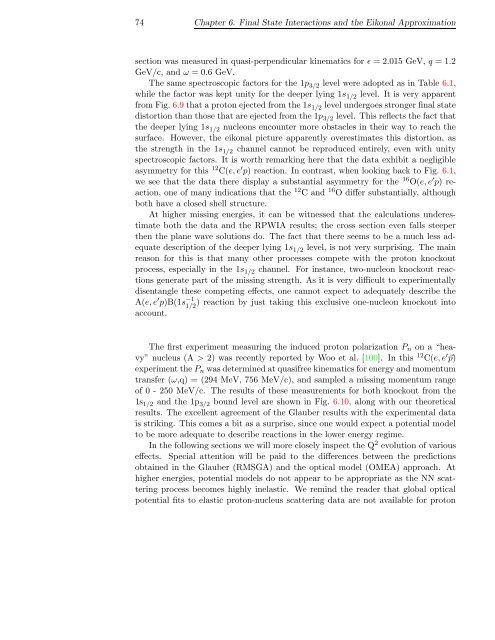Download Thesis in Pdf Format - Theoretical Nuclear Physics and ...
Download Thesis in Pdf Format - Theoretical Nuclear Physics and ...
Download Thesis in Pdf Format - Theoretical Nuclear Physics and ...
You also want an ePaper? Increase the reach of your titles
YUMPU automatically turns print PDFs into web optimized ePapers that Google loves.
74 Chapter 6. F<strong>in</strong>al State Interactions <strong>and</strong> the Eikonal Approximation<br />
section was measured <strong>in</strong> quasi-perpendicular k<strong>in</strong>ematics for ɛ = 2.015 GeV, q = 1.2<br />
GeV/c, <strong>and</strong> ω = 0.6 GeV.<br />
The same spectroscopic factors for the 1p 3/2 level were adopted as <strong>in</strong> Table 6.1,<br />
while the factor was kept unity for the deeper ly<strong>in</strong>g 1s 1/2 level. It is very apparent<br />
from Fig. 6.9 that a proton ejected from the 1s 1/2 level undergoes stronger f<strong>in</strong>al state<br />
distortion than those that are ejected from the 1p 3/2 level. This reflects the fact that<br />
the deeper ly<strong>in</strong>g 1s 1/2 nucleons encounter more obstacles <strong>in</strong> their way to reach the<br />
surface. However, the eikonal picture apparently overestimates this distortion, as<br />
the strength <strong>in</strong> the 1s 1/2 channel cannot be reproduced entirely, even with unity<br />
spectroscopic factors. It is worth remark<strong>in</strong>g here that the data exhibit a negligible<br />
asymmetry for this 12 C(e, e ′ p) reaction. In contrast, when look<strong>in</strong>g back to Fig. 6.1,<br />
we see that the data there display a substantial asymmetry for the 16 O(e, e ′ p) reaction,<br />
one of many <strong>in</strong>dications that the 12 C <strong>and</strong> 16 O differ substantially, although<br />
both have a closed shell structure.<br />
At higher miss<strong>in</strong>g energies, it can be witnessed that the calculations underestimate<br />
both the data <strong>and</strong> the RPWIA results; the cross section even falls steeper<br />
then the plane wave solutions do. The fact that there seems to be a much less adequate<br />
description of the deeper ly<strong>in</strong>g 1s 1/2 level, is not very surpris<strong>in</strong>g. The ma<strong>in</strong><br />
reason for this is that many other processes compete with the proton knockout<br />
process, especially <strong>in</strong> the 1s 1/2 channel. For <strong>in</strong>stance, two-nucleon knockout reactions<br />
generate part of the miss<strong>in</strong>g strength. As it is very difficult to experimentally<br />
disentangle these compet<strong>in</strong>g effects, one cannot expect to adequately describe the<br />
A(e, e ′ p)B(1s −1<br />
1/2<br />
) reaction by just tak<strong>in</strong>g this exclusive one-nucleon knockout <strong>in</strong>to<br />
account.<br />
The first experiment measur<strong>in</strong>g the <strong>in</strong>duced proton polarization P n on a “heavy”<br />
nucleus (A > 2) was recently reported by Woo et al. [100]. In this 12 C(e, e ′ ⃗p)<br />
experiment the P n was determ<strong>in</strong>ed at quasifree k<strong>in</strong>ematics for energy <strong>and</strong> momentum<br />
transfer (ω,q) = (294 MeV, 756 MeV/c), <strong>and</strong> sampled a miss<strong>in</strong>g momentum range<br />
of 0 - 250 MeV/c. The results of these measurements for both knockout from the<br />
1s 1/2 <strong>and</strong> the 1p 3/2 bound level are shown <strong>in</strong> Fig. 6.10, along with our theoretical<br />
results. The excellent agreement of the Glauber results with the experimental data<br />
is strik<strong>in</strong>g. This comes a bit as a surprise, s<strong>in</strong>ce one would expect a potential model<br />
to be more adequate to describe reactions <strong>in</strong> the lower energy regime.<br />
In the follow<strong>in</strong>g sections we will more closely <strong>in</strong>spect the Q 2 evolution of various<br />
effects. Special attention will be paid to the differences between the predictions<br />
obta<strong>in</strong>ed <strong>in</strong> the Glauber (RMSGA) <strong>and</strong> the optical model (OMEA) approach. At<br />
higher energies, potential models do not appear to be appropriate as the NN scatter<strong>in</strong>g<br />
process becomes highly <strong>in</strong>elastic. We rem<strong>in</strong>d the reader that global optical<br />
potential fits to elastic proton-nucleus scatter<strong>in</strong>g data are not available for proton















